Environmental Engineering Reference
In-Depth Information
Figure 5.25.
Features of the self-boring pressuremeter.
The instruments can be used to estimate the effective friction angle of cohesionless
soils and he undrained shear strength of cohesive soils. However disturbance on inser-
tion gives an over-estimate of the undrained strength, so the results should be viewed
with caution. SBPM test results can also be used to estimate the
in situ
horizontal stress
in the ground, an important factor in modelling deformations in dam foundations using
finite element methods, and to establish
in situ
stress conditions for dynamic analysis of
liquefaction. The tests are relatively expensive (in comparison to CPT and SPT) but
affordable on most large dam site investigations.
(e)
Dilatometer
. Refer to Kulhawy and Mayne (1989), Lacasse and Lunne (1988). Powell
and Uglo (1988) for details.
The (Marchetti) dilatometer can be used in a similar way to the CPT. Its proponents
claim advantages over the CPT but these are not apparent to the authors at this time.
(f) Plate bearing tests. Refer to Pells (1983), and Powell and Quarterman (1988) for details.
Plate bearing tests on the surface, in pits or downhole can be useful in assessing the
deformation modulus of soil and weathered rock in a dam foundation. However as the
tests are usually restricted to near the ground surface they are of limited value in a situa-
tion with a thick compressible layer.
Table 5.5
reproduced from Lunne et al. (1997) summarises the applicability of the dif-
ferent
in situ
tests. The authors broadly agree with the table.


